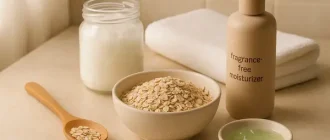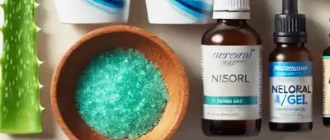Yeast diaper rash is more than just your typical irritation from wet diapers. It’s a fungal infection, often caused by Candida albicans, a yeast that thrives in warm, moist environments. It usually occurs when a standard diaper rash isn’t treated properly or lasts longer than a few days. The rash typically appears bright red with slightly raised borders and may include satellite lesions (smaller red spots nearby).
Prevalence of Diaper Rash in Infants by Age Group
| Age Group (Months) | Infants Affected (%) |
|---|---|
| 1-3 | 10% |
| 4-6 | 15% |
| 7-9 | 20% |
| 10-12 | 25% |
| 13-15 | 18% |
| 16-18 | 12% |
| 19-21 | 8% |
| 22-24 | 5% |
This chart shows the prevalence of diaper rash in infants across various age groups. The data indicates a peak in cases between 10 to 12 months, followed by a gradual decline as the child grows older. Early months show lower prevalence, suggesting increased risk as solid foods and mobility increase.
How Common Is Yeast Diaper Rash?
According to the American Academy of Pediatrics, around 15-40% of diaper rashes develop into yeast infections. It’s especially common in babies who are on antibiotics or have recently had diarrhea.
Duration of Diaper Rash Episodes in Infants
| Duration (Days) | Percentage of Cases (%) |
|---|---|
| 1-3 | 40% |
| 4-6 | 35% |
| 7-9 | 15% |
| 10-12 | 7% |
| 13-15 | 3% |
This chart illustrates how long diaper rash episodes typically last in infants. The majority of cases resolve within 1 to 6 days, while longer episodes become progressively less common. This highlights the effectiveness of early care and treatment in managing the condition.
Common Symptoms to Watch For
- Bright red rash in the diaper area: Often the first sign, this redness may look more intense than a typical diaper rash. It’s usually located where the diaper touches the skin, especially in skin folds.
- Defined edges and red spots spreading outside the main rash: Yeast infections tend to have clear, sharp borders with smaller red “satellite” spots a bit farther out. This is a major visual clue.
- Shiny, inflamed skin: The affected skin often looks glossy or tight, a sign of fungal irritation rather than simple chafing.
- Fussiness during diaper changes: Babies may cry, squirm, or resist diaper changes due to burning or itching in the rash area. If your baby is usually calm but suddenly acts distressed, it could signal discomfort from yeast.
What Causes a Yeast Diaper Rash?
- Prolonged exposure to moisture: Leaving a wet or soiled diaper on too long is the #1 culprit. Moisture weakens the skin barrier and creates an ideal breeding ground for yeast. Many parents underestimate how often babies urinate — newborns can go up to 20 times a day! Forgetting one change overnight or during car rides can trigger a rash.
- Use of antibiotics (in baby or breastfeeding mother): Antibiotics can disrupt the body’s normal microbial balance by killing good bacteria along with the bad. This can allow yeast to overgrow — a common side effect that many parents don’t anticipate, especially if they or their baby were recently treated for an ear or respiratory infection.
- Warm, humid climates: In areas like Florida or southern Texas, the higher humidity increases sweating and dampness in the diaper area. Even with frequent changes, yeast loves this kind of environment. It’s important to use breathable diapers and ensure air drying whenever possible.
- Poor diaper hygiene or infrequent changes: Some parents may mistakenly assume modern diapers absorb everything and don’t need changing as often. Others may apply too many products (creams, powders, oils) that clog pores or trap moisture. Not changing the diaper promptly after bowel movements is another common mistake. Frequent and thorough cleaning with warm water and cotton or fragrance-free wipes helps reduce risk.
Diagnosing Yeast Diaper Rash
While many parents self-diagnose based on appearance, healthcare providers can use several diagnostic tools:
Visual Examination – Accuracy: 6/10 – Cost: $0-$50
The most common and easiest approach. Pediatricians visually inspect the rash for key signs like satellite lesions and bright red patches. No discomfort to the baby, and the entire procedure lasts under 5 minutes. It is non-invasive and typically performed during a regular checkup.
Microscopic Skin Scraping – Accuracy: 8/10 – Cost: $50-$100
This involves gently scraping the outer layer of skin using a sterile tool to collect cells for microscopic analysis. The procedure is brief (2–3 minutes), mildly uncomfortable, but usually well-tolerated with minimal fuss. Infants may cry briefly due to the sensation but recover quickly.
Culture Test – Accuracy: 9/10 – Cost: $70-$150
A soft swab is used to collect a sample from the affected area, which is then sent to a lab. Completely painless and takes less than a minute. The downside? Results take 2–3 days. However, it provides specific identification of the yeast strain, which is crucial for treatment-resistant cases.

Treatment Options That Work
The good news? Yeast diaper rash is treatable — often within a week — with consistent care and proper products.
1. Topical Antifungal Creams
Topical antifungals are the first line of defense and can be purchased without a prescription.
- How to use: Apply a thin layer of Clotrimazole (Lotrimin) or Miconazole (Desenex) directly to the clean, dry rash area twice daily for 7–10 days.
- Effectiveness: 7/10
- Ease of use: 8/10 — Creams absorb quickly but may require gentle handling during application.
- Tip: Use before barrier creams to allow proper absorption.
2. Prescription Antifungal Medications
Stronger than OTC creams, prescription antifungals are used when the rash is severe or persistent.
- How to use: Apply Nystatin cream or ointment to the affected area 3–4 times daily, as directed by your pediatrician.
- Effectiveness: 9/10
- Ease of use: 7/10 — Requires more frequent application but highly effective.
- Tip: Use gloves or clean fingers to avoid spreading the yeast elsewhere.
3. Barrier Creams
These act as a physical shield between the baby’s skin and moisture.
- How to use: Apply generously over the antifungal treatment and diaper area after every change. Look for zinc oxide-based creams like Desitin Maximum Strength or Boudreaux’s Butt Paste.
- Effectiveness: 6/10 (supportive only)
- Ease of use: 9/10 — Simple to apply and long-lasting.
- Tip: Don’t mix barrier and antifungal creams together—layer them.
4. Air Time
Letting skin breathe helps kill off yeast.
- How to use: Allow the baby to go without a diaper for 10–15 minutes, 2–3 times a day, ideally after cleaning.
- Effectiveness: 6/10 (adjunctive)
- Ease of use: 6/10 — Requires setup and close monitoring.
- Tip: Lay a towel under the baby during air time for easier cleanup.
5. Frequent Diaper Changes
Preventing moisture buildup is key.
- How to do it: Change diapers every 2–3 hours, or immediately after a bowel movement.
- Effectiveness: 8/10 (as prevention and support)
- Ease of use: 7/10 — Demands consistency, especially during sleep.
- Tip: Use super-absorbent disposable diapers to reduce skin contact with waste.
New and Innovative Treatments
- Antifungal wipes and sprays: These are especially helpful during travel or overnight care. Simply wipe or spray on the clean, dry diaper area before applying a barrier cream. No rubbing needed, which reduces discomfort. Effectiveness: 7/10. Ease of use: 9/10. Popular option: Dr. Smith’s Antifungal Diaper Rash Spray.
- Probiotic supplements: Ideal for babies who have recently taken antibiotics. These drops or powders (e.g., Culturelle Baby) are mixed with milk or formula once a day. They help restore healthy gut flora and reduce yeast overgrowth. Effectiveness: 7/10. Ease of use: 8/10.
- Silicone barrier sprays: These sprays form a breathable yet waterproof shield over the skin without the mess of thick creams. They’re fast-drying and great for wriggly babies. Spray evenly on clean, dry skin after treatment creams. Effectiveness: 6/10. Ease of use: 9/10. Examples include Cavilon No Sting Barrier Film.
Real Medical Case Example
A 9-month-old girl in Houston, TX, developed a persistent diaper rash after a week of antibiotics for an ear infection. The rash worsened despite regular diaper rash cream. A pediatrician identified it as yeast-based, prescribed Nystatin, and advised air drying. Rash resolved in 5 days.
Table: Quick Comparison of Treatments
| Treatment Type | Example Product | Application Frequency | Estimated Cost | Effectiveness (1-10) |
|---|---|---|---|---|
| OTC Antifungal Cream | Clotrimazole, Miconazole | 2x/day | $5–$10 | 7 |
| Prescription Antifungal | Nystatin | 3–4x/day | $10–$30 | 9 |
| Barrier Cream | Desitin, Boudreaux’s Paste | Every diaper change | $4–$12 | 6 |
| Probiotic Supplement | Culturelle Baby | Daily (if needed) | $15–$25 | 7 |
Editorial Advice
Reyus Mammadli, healthcare advisor, recommends starting with OTC antifungal creams at the first sign of a yeast rash. “If symptoms don’t improve in 3 days, it’s time to escalate to a pediatrician for prescription-strength treatment,” he advises. Avoid using regular diaper rash creams alone on a yeast rash — they often trap moisture and worsen the issue. Instead, opt for breathable fabrics, frequent changes, and a dual-approach of antifungal plus barrier protection.
Incidence of Yeast Diaper Rash in Breastfed vs. Formula-Fed Infants
The chart compares the incidence of yeast diaper rash in infants based on feeding method. Formula-fed infants show a higher rate of occurrence (18%) compared to breastfed infants (12%), potentially due to differences in gut flora and immune protection from breast milk.
For parents dealing with recurring cases, keep an eye on antibiotic usage, and consider incorporating daily air time and probiotics. It’s all about balance and consistency — and yes, changing diapers like a pro.
References
- American Academy of Pediatrics. Diaper Rash: Clinical Practice Guidelines. 2022.
- Mayo Clinic. Yeast diaper rash: Symptoms and causes. Updated 2023.
- CDC. Candida albicans – Fungal Diseases. Centers for Disease Control and Prevention.
- Cleveland Clinic. Diaper Rash: Diagnosis & Treatment. Last reviewed 2023.
- Culturelle Baby and Dr. Smith’s product manufacturer information sheets.
About the Author
Reyus Mammadli is the author of this health blog since 2008. With a background in medical and biotechnical devices, he has over 15 years of experience working with medical literature and expert guidelines from WHO, CDC, Mayo Clinic, and others. His goal is to present clear, accurate health information for everyday readers — not as a substitute for medical advice.







